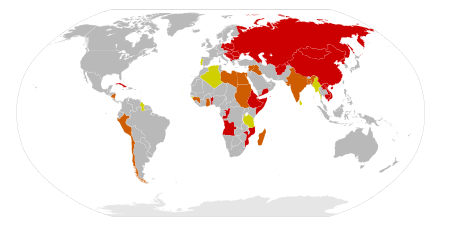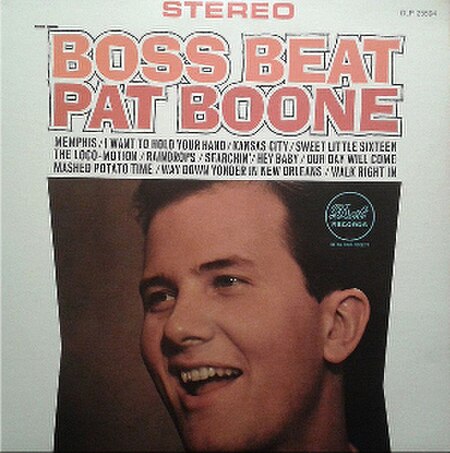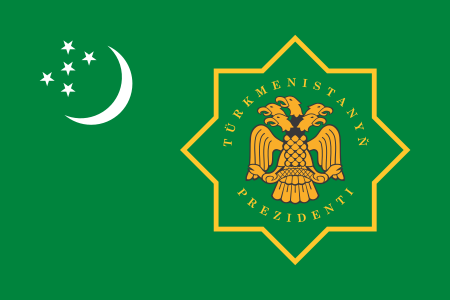Linguasphere Observatory
|
Read other articles:

RaihaanunRaihaanun di tahun 2019LahirSiti Hafar Raihaanun Nabilla[1]7 Juni 1988 (umur 35)Jakarta, IndonesiaPekerjaanAktrismodelTahun aktif2003—sekarangKaryaDaftar filmografiSuami/istriTeddy Soeriaatmadja (m. 2007; c. 2023)Anak3KerabatItang Yunasz (paman)PenghargaanDaftar penghargaan Siti Hafar Raihaanun Nabilla (lahir 7 Juni 1988) adalah seorang pemeran dan model Indonesia. Raihaanun memulai kariernya dari modeling dengan me…

Square in Helsinki, Finland Aerial view of the Eliel Square right next to the Helsinki Central Station. The Eliel Square (Finnish: Elielinaukio, Swedish: Elielplatsen) is a square on the west side of the Helsinki Central Station in the heart of Helsinki, Finland. It is named after the railway station designer Eliel Saarinen. The square is for the most part the departure and arrival platforms for regional buses. At the northern end of the square is the Holiday Inn Hotel and at the southern end is…

Third World countries which the USSR recognized as adhering to the ideas of socialism Part of a series onMarxism–Leninism Concepts Administrative-command system Anti-imperialism Anti-revisionism Central planning Soviet-type economic planning Collective farming Collective leadership Commanding heights of the economy Democratic centralism Dialectical logic Dialectical materialism Foco Intensification of the class struggleunder socialism Labor aristocracy Marxist–Leninist atheism One-party stat…

この記事は検証可能な参考文献や出典が全く示されていないか、不十分です。出典を追加して記事の信頼性向上にご協力ください。(このテンプレートの使い方)出典検索?: コルク – ニュース · 書籍 · スカラー · CiNii · J-STAGE · NDL · dlib.jp · ジャパンサーチ · TWL(2017年4月) コルクを打ち抜いて作った瓶の栓 コルク(木栓、蘭&…

Questa voce o sezione sull'argomento storia contemporanea non è ancora formattata secondo gli standard. Commento: La voce ha subito una prima parziale wikificazione da me, Utente:LucaLindholm, nel 24 giugno 2022. Non resta che continuare ad eliminare parti inutili, esagerate o di pura opinione. Contribuisci a migliorarla secondo le convenzioni di Wikipedia. Segui i suggerimenti del progetto di riferimento. Questa voce o sezione sull'argomento storia contemporanea è priva o carente di…

1964 studio album by Pat BooneBoss Beat!Studio album by Pat BooneReleased1964GenrePopLabelDotPat Boone chronology The Lord's Prayer and Other Great Hymns(1964) Boss Beat!(1964) Near You(1964) Professional ratingsReview scoresSourceRatingAllMusic[1]BillboardSpecial merit pick[2] Boss Beat! is a studio album by Pat Boone, released in 1964 on Dot Records.[1][2][3] Track listing Side oneNo.TitleWriter(s)Length1.MemphisChuck Berry2:342.I Want to Hold Yo…

土库曼斯坦总统土库曼斯坦国徽土库曼斯坦总统旗現任谢尔达尔·别尔德穆哈梅多夫自2022年3月19日官邸阿什哈巴德总统府(Oguzkhan Presidential Palace)機關所在地阿什哈巴德任命者直接选举任期7年,可连选连任首任萨帕尔穆拉特·尼亚佐夫设立1991年10月27日 土库曼斯坦土库曼斯坦政府与政治 国家政府 土库曼斯坦宪法 国旗 国徽 国歌 立法機關(英语:National Council of Turkmenistan) 土�…

Siege of QueliPart of Sajid invasion of GeorgiaA painting of St. Mikel-Gobron by Mikhail Sabinin.DateSeptember 20 - October 17, 914LocationQueli, present-day TurkeyResult Sajid victory [note 1]Territorialchanges The Sajids briefly gain Samtskhe only to lose it in the same year to the Georgians.Belligerents Kingdom of the Iberians Sajid dynastyCommanders and leaders Gobron Yusuf ibn Abi'l-SajStrength 200[1] 20,000[1]Casualties and losses 133[1] Heavy The sie…
2020年夏季奥林匹克运动会波兰代表團波兰国旗IOC編碼POLNOC波蘭奧林匹克委員會網站olimpijski.pl(英文)(波兰文)2020年夏季奥林匹克运动会(東京)2021年7月23日至8月8日(受2019冠状病毒病疫情影响推迟,但仍保留原定名称)運動員206參賽項目24个大项旗手开幕式:帕维尔·科热尼奥夫斯基(游泳)和马娅·沃什乔夫斯卡(自行车)[1]闭幕式:卡罗利娜·纳亚(皮划艇)[2…

Scottish judge and literary critic This article needs additional citations for verification. Please help improve this article by adding citations to reliable sources. Unsourced material may be challenged and removed.Find sources: Francis Jeffrey, Lord Jeffrey – news · newspapers · books · scholar · JSTOR (February 2009) (Learn how and when to remove this message) An 1820 portrait of Lord Jeffrey by Andrew Geddes Francis Jeffrey by Patric Park, 1840, Natio…

President of Austria from 2004 to 2016 Heinz FischerGColIH, OMRI, RSerafO, GCollSEFischer in 2018President of AustriaIn office8 July 2004 – 8 July 2016ChancellorWolfgang SchüsselAlfred GusenbauerWerner FaymannChristian KernPreceded byThomas KlestilSucceeded byAlexander Van der BellenSecond President of the National CouncilIn office20 December 2002 – 16 June 2004Preceded byThomas PrinzhornSucceeded byBarbara PrammerPresident of the National CouncilIn office5 November 1990&#…

Kamil Bahren Pasha Danbrigif Para Raider 3/Tri Budi SaktiMasa jabatan28 Maret 2022 – 2023PendahuluFadli MulyonoPenggantiEko Antoni Chandra Listianto Informasi pribadiLahir20 November 1977 (umur 46)Bandung, Jawa Barat, IndonesiaSuami/istriNy. drg. Lidya AfrinawatiHubunganBasrizal Koto (Mertua)Anak4Orang tuaMuslim Kasim (Alm)Alma materAkademi Militer (2000)Universitas Azzahra (2012)[1]Sekolah Tinggi Ilmu Administrasi Mandala (2014)[2]Karier militerPihak Indones…

Artikel atau sebagian dari artikel ini mungkin diterjemahkan dari Superintendent of the United States Military Academy di en.wikipedia.org. Isinya masih belum akurat, karena bagian yang diterjemahkan masih perlu diperhalus dan disempurnakan. Jika Anda menguasai bahasa aslinya, harap pertimbangkan untuk menelusuri referensinya dan menyempurnakan terjemahan ini. Anda juga dapat ikut bergotong royong pada ProyekWiki Perbaikan Terjemahan. (Pesan ini dapat dihapus jika terjemahan dirasa sudah cukup t…

For other uses, see Clos (disambiguation). Standard method combination in ANSI common lisp The Common Lisp Object System (CLOS) is the facility for object-oriented programming in ANSI Common Lisp. CLOS is a powerful dynamic object system which differs radically from the OOP facilities found in more static languages such as C++ or Java. CLOS was inspired by earlier Lisp object systems such as MIT Flavors and CommonLoops, although it is more general than either. Originally proposed as an add-on, C…

Cultural coffee drinking practices in the former Yugoslavia Part of a series onYugoslavs By region Canada Serbia United States Culture Yugoslav studies Architecture Art Cinema Films Coffee culture Music Philosophy Sport Football Yugo-nostalgia Yugosphere History Yugoslavism Yugoslav irredentism Pan-Slavism Creation of Yugoslavia Yugoslavia Kingdom Socialist Federal Republic Federal Republic Breakup of Yugoslavia Yugoslav Wars Languages Bulgarian Macedonian Serbo-Croatian Serbian Croatian Bosnian…

Newspaper in Far North Queensland, Australia The Cairns PostFront page, 12 February 2024TypeDaily newspaperFormatTabloid, Berliner (Weekend Post from 2017)Owner(s)News LimitedEditorTyla HarringtonFounded10 May 1883HeadquartersCairnsWebsitewww.cairnspost.com.au Premises of The Cairns Post on Abbott Street (2016) The original founder FT0Wimble First office of the Cairns Post on Lake Street (1886) Morning Post (Cairns) - Premises after the cyclone 1906 The Cairns Post is a major News Corporation ne…

Ruling royal family of Brunei House of BolkiahRoyal familyEmblem of the Sultan of BruneiParent familyBanu Qatadah, of Banu Hassan, of Banu Hashim, of Quraysh (since 1425 due to cognatic inheritance)CountryBrunei Darussalam (previously the Bruneian Empire)Place of originAllegedly Tarim, Emirate of ZabidFounded1363 or 1368FounderSultan Muhammad ShahCurrent headHassanal BolkiahTitlesSultan of BruneiCrown Prince of Brunei this article is part of a series on thepolitics ofBrunei Darussalam Sultan Has…

Town in Louisiana, United StatesGrand Isle, LouisianaTownTown of Grand IsleLighthouse Christian Fellowship Church SealLocation of Grand Isle in Jefferson ParishLocation of Louisiana in the United StatesCoordinates: 29°14′N 90°00′W / 29.233°N 90.000°W / 29.233; -90.000[1]CountryUnited StatesStateLouisianaParishJeffersonGovernment • MayorDavid Camardelle Sr. (D)Area[2] • Total8.17 sq mi (21.17 km2) • …

Batalla de Túnez Parte de séptima guerra siciliana Fecha 310 a. C.Lugar Túnez, Cartago.Resultado Victoria de SiracusaBeligerantes Siracusa Cartago Comandantes Agatocles Hannón†Bomílcar Bajas 200 (Diodoro)2.000 (Justino) 1.000- 6.000 (Diodoro)3.000 (Justino) [editar datos en Wikidata] Guerras sicilianas480 a. C.-307 a. C.1.ª de Hímera Selinunte 2.ª de Hímera Acragante Gela Camarina Motia Segesta Mesina Catania 1.ª de Siracusa Tauromenio Abaceno …

Radio show White Marriage19 May 1951 issue of ABC WeeklyGenredrama serialRunning time60 minsCountry of originAustraliaLanguage(s)EnglishStarringKeith EdenElizabeth WingWritten byMorris WestRecording studioMelbourneOriginal release1951No. of series1No. of episodes13[1] White Marriage is a 1951 Australian radio serial by Morris West.[2] It concerned a British man who marries a German girl so she can get British citizenship.[3] The serial was based on research West did in Ge…